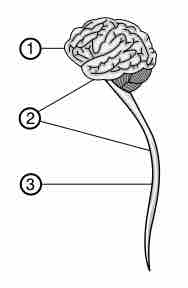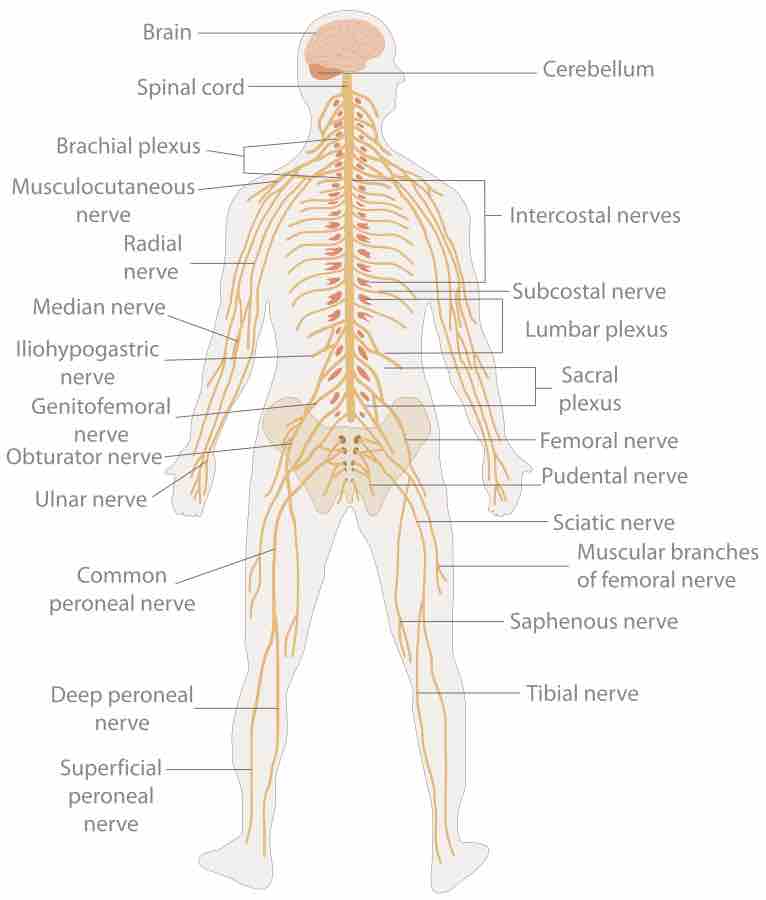The nervous system is comprised of two major subdivisions, the central nervous system (CNS) and the peripheral nervous system (PNS).
Central Nervous System
The CNS includes the brain and spinal cord along with various centers that integrate all the sensory and motor information in the body. These centers can be broadly subdivided into lower centers, including the spinal cord and brain stem, that carry out essential body and organ-control functions and higher centers within the brain that control more sophisticated information processing, including our thoughts and perceptions. Further subdivisions of the brain will be discussed in a later section.

The Central Nervous System
The central nervous system (2) is a combination of the brain (1) and the spinal cord (3).
Gray Matter and White Matter
The nervous system is often divided into components called gray matter and white matter. Gray matter, which is gray in preserved tissue but pink or light brown in living tissue, contains a relatively high proportion of neuron cell bodies. Conversely, white matter is composed mainly of axons and is named because of the color of the fatty insulation called myelin that coats many axons. White matter includes all of the nerves of the PNS and much of the interior of the brain and spinal cord. Gray matter is found in clusters of neurons in the brain and spinal cord and in cortical layers that line their surfaces.
By convention, a cluster of neuron cell bodies in the gray matter of the brain or spinal cord is called a nucleus, whereas a cluster of neuron cell bodies in the periphery is called a ganglion. However, there are a few notable exceptions to this rule, including a part of the brain called the basal ganglia, which will be discussed later.
Peripheral Nervous System
The PNS is a vast network of nerves consisting of bundles of axons that link the body to the brain and the spinal cord. Sensory nerves of the PNS contain sensory receptors that detect changes in the internal and external environment. This information is sent to the CNS via afferent sensory nerves. Following information processing in the CNS, signals are relayed back to the PNS by way of efferent peripheral nerves.
Autonomic and Somatic Nervous Systems
The PNS is further subdivided into the autonomic nervous system (ANS) and the somatic nervous system. The autonomic system has involuntary control of internal organs, blood vessels, and smooth and cardiac muscles. The somatic system has voluntary control of our movements via skeletal muscle.
As mentioned, the autonomic nervous system acts as a control system and most functions occur without conscious thought. The ANS affects heart rate, digestion, respiratory rate, salivation, perspiration, pupil diameter, urination, and sexual arousal. While most of its actions are involuntary, some, such as breathing, work in tandem with the conscious mind. The ANS is classically divided into two subsystems: the parasympathetic nervous system (PSNS) and sympathetic nervous system (SNS).
Parasympathetic and Sympathetic Nervous Systems
Broadly, the parasympathetic system is responsible for stimulation of "rest-and-digest" activities that occur when the body is at rest, including sexual arousal, salivation, lacrimation (tears), urination, digestion, and defecation. The sympathetic nervous syste is responsible for stimulating activities associated with the "fight-or-flight" response: mobilizing the systems of the body for escape or attacking sources of danger. In truth, the functions of both the parasympathetic and sympathetic nervous systems are not so straightforward, but this division is a useful rule of thumb.
The enteric nervous system (ENS) controls the gastrointestinal system and is sometimes considered part of the autonomic nervous system. However, it is sometimes considered an independent system because it can operate independently of the brain and the spinal cord.

The Nervous System of a Vertebrate
The brain and the spinal cord are the central nervous system (CNS) (shown in yellow). The left-right pair of cranial nerves, spinal nerves, and ganglia make up the peripheral nervous system (shown in dark gold).